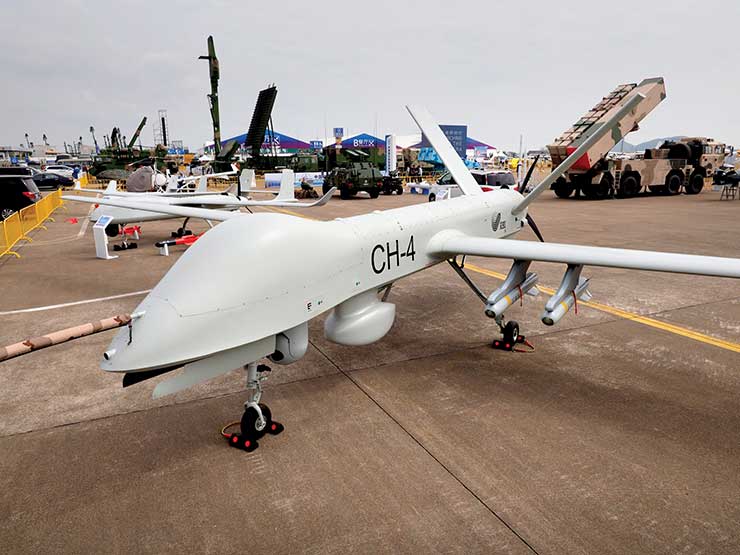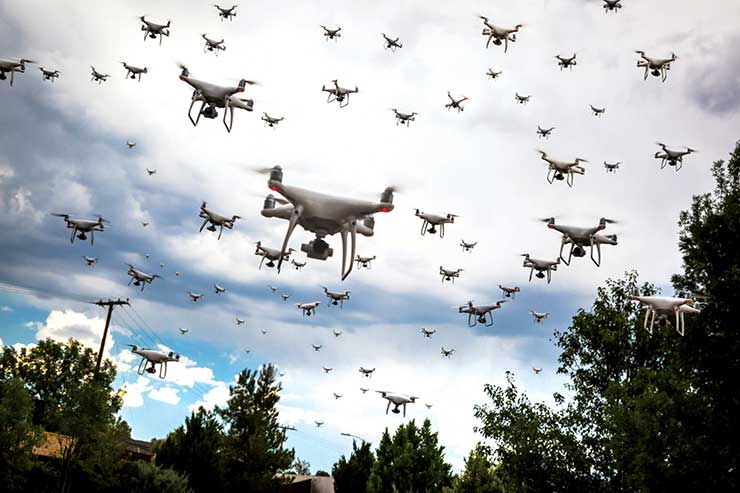In 2018, India’s elite Special Forces unit, the National Security Guard, acquired the world’s smallest micro drone, the Black Hornet. Weighing just 33 grams and able to fly 25 minutes on a single charge, the drone gives soldiers a new level of stealth capability. Instead of sending scouts to look if any terrorists or enemy fighters are hiding in a targeted area, the Black Hornet can be deployed to look inside compounds and to clear a route through enemy-held spaces.
Made in Norway by the US company Teledyne FLIR, the Black Hornet is essentially a miniaturised flying camera designed to approach enemy positions without being seen or heard, and transmit relatively low-resolution 640 x 480 pixel video to troops up to 2 km away. It is also able to snap and transmit still photos of 1600 x 1200 pixels, and is equipped with basic thermal imagery to help identify enemy positions at night. The complete system (including two drones, flip screen and joystick controller) weighs 1.3 kg and costs $94,000.
Designed to be used as part of the US Army’s Soldier Borne Sensor (SBS) programme – tools carried by an individual soldier to support small unit-level surveillance and reconnaissance capabilities – the Black Hornet provides soldiers with immediate covert situational awareness to help them perform missions more effectively.
More than 12,000 of these nano-UAVs have been delivered to defence and security forces worldwide. Recently, Ukraine was awarded a military aid package that included 850 Black Hornets. With Russia certainly developing similar drones to acquire parity with its adversary, the Ukraine War will truly be the coming of age of military nano drones.
Small is beautiful – and deadly
Next time you spot a bee or dragonfly around you, take a closer look. What might appear to be an insect could turn out to be a miniature (or nano) drone being controlled by someone far away. This isn’t science fiction but science fact. Packing a lot of functionality into a tiny form factor, nano drones are becoming a major military tool. Not only do they offer a quantum leap in surveillance capability, they hold the possibility of conducting swarm attacks on the enemy.
PK Garg writes in “Unmanned Aerial Vehicles: An Introduction” (2021) that UAVs are becoming a valuable tool for military commanders in the preparation and execution of missions. “With the increasing use of UAVs in the battlespace, coupled with robust communications systems, data may soon be available to every soldier. The US Army plans to give almost all of its ground combat units tiny drones which can spy on other forces from the sky. These UAVs can be further developed to be used as flying camouflage drones (that will visually mask everything nearby), communication disruptors (that will create zero-communication zones over the targeted areas), and battlefield medical supply drones (to provide a source of supplies and equipment for battlefield injuries instantly).”
According to Group Captain Atul Pant of the Indian Air Force, new generation aerial drones will eventually be at the centre stage of military operations, in both lethal and non-lethal roles. In a paper titled ‘Aerial Drones in Future Wars: A Conceptual Perspective’, presented at the New Delhi-based Manohar Parrikar Institute for Defence Studies and Analyses, he writes: “Modern disruptive technologies like Artificial Intelligence, Internet of Things, miniaturised electronics, composites, etc., are taking the capabilities of unmanned systems to new highs and increasing autonomy in their usage by turning them into smart and intelligent machines. With further advancement of technology, their role in warfare is set to increase exponentially.”
Drones: Soldiers of the future
A good intelligence capability is critical to win wars. The right information at the right time could mean the difference between lives saved and lives lost. This is the area in which nano drones will be used primarily, at least in the early phase. When your mission means everything, intelligent imaging ensures success. Instant access to real-time intelligence of the situation – especially when beyond your line of sight – is vital. “With a camera in the air vehicle, soldiers will be able to see further and around obstacles that they previously wouldn’t be able to see in near real time,” the US Army says in a draft Request for Proposal for Soldier Borne Sensors.
Writes Garg: “Drone operators could drop a sophisticated surveillance tool to a restricted area for eavesdropping if there are no power, weight and range issues. Putting a Wi-Fi access point on top of a building, or inside its perimeter, could allow hackers to listen in to data traffic. Drones can also be used to carry traditional spying devices used to eavesdrop on a conversation (such as a laser microphone) and perform key logging (using a microphone).”

Weaponised nano drones are next. While the cheapest of these systems can carry only small payloads, the rapidly developing field of nano-energetics or nano-explosives will dramatically increase their destructive power. T.X. Hammes of the US National Defense University writes: “As early as 2002, nano-explosives demonstrated an explosive power twice that of conventional explosives. Since research in this field is classified, proprietary, or both, it is difficult to say what, if any progress has been made since that point. But even if double the power is as good as it gets, a 100 per cent increase in destructive power for the same size weapon is a massive increase.”
Drone miniaturisation is also driven by logistics. For at least a century, much has been written about the soldier’s load, meaning that they go into combat carrying heavy stuff that inhibits their effectiveness. While a tiny drone, the size of a sparrow or even a bumblebee may not sound like much, it could be enough of a tipping point to limit combat effectiveness. Thus, a lot of emphasis has been placed on weight limitations.
The US Army is looking at drones not weighing over 150 grams and perhaps fitting in a soldier’s cargo pocket where it could be trickle charged in two hours or less. Ideally, the drone would fly about 1,000 metres, 50 to 70 feet in the air for 10 to 15 minutes. That would considerably enhance the situational awareness of a platoon-sized group, allowing the soldiers to control and dominate their area out to the limits of their small-arms fire capabilities. These mini drones are expected to be as quiet as a bumble bee so as not to alert the enemy. The system should also be simple so that soldiers can operate it with a minimum of training time.
Swarm robotics
As drone technology evolves, the more traditional military uses for unmanned systems are joined by new applications. Smaller drones can work together to target larger aircraft or missiles. This is known as swarm robotics. According to a report titled “The Coming Swarm: The Quality of Quantity” published by the Center for New American Security (CNAS), a foreign policy and national security think tank, the heightened “vulnerability” of assets to vessels and aircraft has led to investment in emerging robotic technologies that can “fight as a swarm”.
The Pentagon’s Strategic Capabilities Office division has tested micro drones that can be deployed in the swarm role. These 3D-printed UAVs were launched from a canister and were instructed to find one another in the air. Ironically, even as countries develop swarm robotics for offensive purposes, they will have to also look to develop systems to protect against foreign swarms.
Group Captain Pant believes that from an air force’s point of view, small drones are evolving to become very potent air launched intelligent autonomous weapons. With designs to launch from high speed aerial platforms as well as missile mounted canisters in swarms near the target, and armed with potent customised explosives, small sacrificial drones could splendidly serve the purpose of the air forces for striking soft and semi-soft targets deep inside enemy territory (like parked aircraft inside blast protected shelters in airfields, communication facilities, fuel bowsers, radars, etc., and even strategic value targets like cracking towers of oil refineries), while saturating the enemy airspace as well as radars (always the much preferred tactic by air forces).

The tactical employment of drones in contested airspaces is likely to be mostly in mass, where they saturate the airspace and make discernment of the actual lethal ones and the decoys difficult.
Size matters. Says Pant: “Drones integrated with the first wave of attack in a frontal land assault need to be small, expendable/self-sacrificial winged swarms swooping in, and intelligently targeting soldiers or combat entities at speed and causing a large number of casualties/damage. Besides being low in cost, these would bring shock and awe. These would be much more effective than a few high flying slow drones targeting enemy positions and combatants, where they are likely to be rather easily targeted by the enemy.”
Nano drones would be less vulnerable to enemy fire due to their smaller size, and their inbuilt evasive manoeuvring and dodging capability. Since the unit costs would not be very high, large numbers could be packaged together for any mission, including a mix of recoverable as well as expendable/self-sacrificial drones in the package. Designed with stealth, jet engines, electronic warfare suite, and advanced weapons, such drone packages could become a force to reckon with.
India’s opportunity
US-based Allied Market Research says work on both general-purpose and military drones has gained traction worldwide, and the global nano drone market could reach $13.4 billion by 2023. Investment in drone R&D is still miniscule in India, but on the bright side India’s leadership position in software can help it capture a significant chunk of this market.
A key factor which will influence the role of military drones is artificial intelligence (AI) which, together with miniaturisation of electronics, is likely to give immense capabilities to smaller drones. AI would open up a wide range of functional capabilities in drones, many of which were so far considered unviable to be performed autonomously by machines.
Another aspect is managing power. Although miniature drones have become quite common in the past few years, their primary weakness is that most of their battery power goes into making them fly, leaving little energy for other operations. To resolve this issue, scientists are looking to combine algorithms and hardware in a single chip.
India’s edge in software could be a game changer if the vast pool of IT talent could be tapped. As AI advances in the future, it is likely to require custom designed chips for drones, with higher processing power along with the miniaturisation of other electronic components and sensors, particularly for smaller drones. This would need an enhanced R&D effort in hardware designing, especially for the nations who are new to the field of drones and AI.
Resilience against electronic warfare and cyber warfare will be other challenges in designing drone hardware. Says Group Captain Pant: “A very sensitive issue is the possibility of backdoors and trapdoors in the imported chips, electronics and software, making them vulnerable to cyber interference or attacks — which can render them totally unusable — even in mass at times. Indigenisation in these fields would be essential.”
If India is to make the successful transition from a balancing to a leading power, self reliance in technology is critical. Although a late starter, the Indian military is embracing drones with gusto. The Indian Army, for instance, has taken several technology initiatives in partnership with startups, MSMEs, the private sector, the Defence Research and Development Organisation (DRDO) and defence PSUs.

One such project is Offensive Operations that the Army is incubating with a Bangalore-based startup. In a live demonstration for army officers in January 2021, a swarm of 75 drones carried out a series of randomised, autonomous swarming missions without any human intervention and driven by continuous satellite feeds. This was achieved via close interaction between onboard computers, smart artificial intelligence algorithms, advanced photometry and better target designation.
The DRDO has also entered the game with its ALFA-S swarming micro-drone designed for surface offensive purposes.
Growing Chinese capabilities
China has a successful military UAV programme, which has been supplying drones to buyers across the world. The varieties of Chinese drones probably now exceeds those in the US. The Chinese developed their UAVs on pilfered and reverse engineered technologies, but have subsequently improved upon them to develop the current state-of-the-art ones. Chinese CH-4 UCAVs have already seen employment by the Iraq military in several hundred missions against rebels.
In 2017, the attack drone GJ-2 flew over the 8,848 metre high Mount Everest, demonstrating Beijing’s ability to monitor Indian military movements round the clock. China’s EA-03 high-altitude, long-endurance drone is publicised to have a range of 7,000 km, a maximum endurance of 36 hours, advanced command communications, and electronic warfare systems. In October 2018, China demonstrated the TW-365 heavy lift cargo drone, and successfully tested the world’s largest unmanned transport drone capable of carrying up to 1.5 tons of load.
At the same time, China is strengthening its surveillance network with birdlike small drones. The Chinese government’s “Dove” programme has been building small drones that resemble birds. In the past few years, at least 30 military and government agencies have deployed these fake birds in five provinces.
According to Robotics Business Review, these small drones take flight similar to how birds do so, fly up to the speed of 40 kph and have a wingspan of 50 cm. The Doves are equipped with high-definition cameras, flight-control systems, GPS antennas, and data links with satellite communication capability.
The technology is in its infancy. Tiny drones can be hampered by strong winds, snow, or rain. In addition, electromagnetic fields can disrupt their operation. However, it is only a matter of time before the Chinese build better versions of the Dove that can fly in these conditions. China’s drone swarming capability currently exceeds 1,000 drones.
Since Pakistan is China’s guinea pig (test market), it is reasonable to expect that the Islamic terror exporting country will at some point get hold of stripped down export models of nano drones like the Dove.
Conclusion
Living in one of the world’s most dangerous neighbourhoods, with radical Islamists on both flanks and an expansionist communist bully on the northern border, India has no choice but to stay ahead of these existential enemies. A close partnership between government agencies and the private sector alone can ensure that developmental work can produce world class drones. With China integrating drones into all wings of its military, it is critical that India accord high priority to military drone development.
Robotic warfare expert Peter Singer writes in “Wired for War” that remote warfare is changing mankind’s monopoly on how conflict is fought for the first time in 5,000 years. “All that limits its advance is its application, not the technology. The barriers of war in our society are already lowering.”
–The writer is a globally cited defence analyst. His work has been published by leading think tanks, and quoted extensively in books on diplomacy, counter terrorism, warfare and economic development. The views expressed are personal and do not necessarily reflect the views of Raksha Anirveda
–The writer is a globally cited defence analyst based in New Zealand. The views expressed are of the writer and do not necessarily reflect the views of Raksha Anirveda






